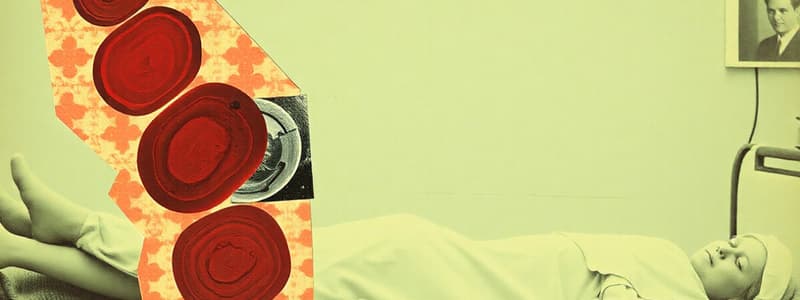Podcast
Questions and Answers
According to the Braden Scale, which sensory perception score indicates the highest risk for pressure ulcer development?
According to the Braden Scale, which sensory perception score indicates the highest risk for pressure ulcer development?
- Completely limited; unresponsive to painful stimuli due to diminished level of consciousness. (correct)
- Very limited; responds only to painful stimuli and cannot communicate discomfort except by moaning.
- No impairment; responds to verbal commands and has no sensory deficit.
- Slightly limited; responds to verbal commands but cannot always communicate discomfort.
A patient who "walks occasionally during the day, but for very short distances, with or without assistance" would receive what score for activity level on the Braden Scale?
A patient who "walks occasionally during the day, but for very short distances, with or without assistance" would receive what score for activity level on the Braden Scale?
- 2
- 1
- 3 (correct)
- 4
In the context of the Braden Scale, which of the following best describes a 'potential problem' regarding friction and shear?
In the context of the Braden Scale, which of the following best describes a 'potential problem' regarding friction and shear?
- Requires moderate to maximum assistance in moving; sliding against sheets is impossible.
- No apparent movement as patient is bedfast.
- Patient moves feebly or requires minimum assistance; skin probably slides to some extent against surfaces. (correct)
- Patient moves in bed and chair independently and has sufficient muscle strength to lift completely.
Which of the following statements accurately reflects the 'moisture' category scoring in the Braden Scale?
Which of the following statements accurately reflects the 'moisture' category scoring in the Braden Scale?
A patient eats over half of most meals, consumes four servings of protein daily, and occasionally takes a supplement. What score should they receive on the nutrition portion of the Braden Scale?
A patient eats over half of most meals, consumes four servings of protein daily, and occasionally takes a supplement. What score should they receive on the nutrition portion of the Braden Scale?
According to the Braden Scale, what mobility score would you assign to a patient who makes frequent though slight changes in body or extremity position independently?
According to the Braden Scale, what mobility score would you assign to a patient who makes frequent though slight changes in body or extremity position independently?
A patient who is chairfast and needs assistance into a wheelchair would receive what score for activity according to the Braden Scale?
A patient who is chairfast and needs assistance into a wheelchair would receive what score for activity according to the Braden Scale?
How does 'sensory perception' as defined by the Braden Scale, MOST directly relate to the formation of pressure ulcers?
How does 'sensory perception' as defined by the Braden Scale, MOST directly relate to the formation of pressure ulcers?
What is the significance of regularly reassessing patients with established pressure ulcers, as mentioned in the provided text?
What is the significance of regularly reassessing patients with established pressure ulcers, as mentioned in the provided text?
According to the information presented, a patient with a Braden Scale score of 13 or 14 is considered to be at what risk level for developing pressure ulcers?
According to the information presented, a patient with a Braden Scale score of 13 or 14 is considered to be at what risk level for developing pressure ulcers?
Flashcards
Sensory Perception
Sensory Perception
Ability to respond meaningfully to pressure-related discomfort.
Moisture
Moisture
Degree to which skin is exposed to moisture.
Activity
Activity
Degree of physical activity.
Mobility
Mobility
Signup and view all the flashcards
Nutrition
Nutrition
Signup and view all the flashcards
Friction and Shear
Friction and Shear
Signup and view all the flashcards
Completely Limited Sensory Perception
Completely Limited Sensory Perception
Signup and view all the flashcards
Constantly Moist
Constantly Moist
Signup and view all the flashcards
Bedfast
Bedfast
Signup and view all the flashcards
Completely Immobile
Completely Immobile
Signup and view all the flashcards
Study Notes
- Bed- and chair-bound individuals with impaired ability to reposition themselves should be assessed for risk of developing pressure ulcers.
- Patients with established pressure ulcers should be reassessed periodically.
Sensory Perception
- This assesses a patient's ability to respond meaningfully to pressure-related discomfort.
- Completely Limited: Unresponsive to painful stimuli due to diminished consciousness/sedation or limited ability to feel pain over most of the body.
- Very Limited: Responds only to painful stimuli, cannot communicate discomfort except by moaning or restlessness, or has sensory impairment limiting pain/discomfort sensation to half of body.
- Slightly Limited: Responds to verbal commands, but cannot always communicate discomfort/need, or has sensory impairment limiting pain/discomfort sensation to one or two extremities.
- No Impairment: Responds to verbal commands, has no sensory deficit limiting ability to feel or voice pain/discomfort.
Moisture
- This refers to the degree to which the skin is exposed to moisture.
- Constantly Moist: Skin is kept moist constantly by perspiration/urine, dampness detected with every turn.
- Very Moist: Skin is often moist, linen changed once a shift.
- Occasionally Moist: Skin is occasionally moist, requiring extra linen change once a day.
- Rarely Moist: Skin is usually dry, linen only requires changing at routine intervals.
Activity
- This refers to the degree of physical activity.
- Bedfast: Confined to bed.
- Chairfast: Ability to walk severely limited or non-existent, cannot bear weight and/or needs assistance into chair or wheelchair.
- Walks Occasionally: Walks occasionally during day, but for short distances, with or without assistance, spends majority of each shift in bed or chair.
- Walks Frequently: Walks outside the room at least twice a day and inside room at least once every 2 hours during waking hours.
Mobility
- This assesses the ability to change and control body position.
- Completely Immobile: Does not make even slight changes in body/extremity position without assistance.
- Very Limited: Makes occasional slight changes in body/extremity position but unable to make frequent/significant changes independently.
- Slightly Limited: Makes frequent though slight changes in body/extremity position independently.
- No Limitations: Makes major and frequent changes in position without assistance.
Nutrition
- This refers to the usual food intake pattern.
- Very Poor: Never eats a complete meal, rarely eats more than 1/3 of food offered, eats two or fewer servings of protein per day, takes fluids poorly, does not take supplements, or is NPO/on clear fluids or IVs for more than 5 days.
- Probably Inadequate: Rarely eats a complete meal, generally eats about half of food offered, protein intake includes about three servings per day, occasionally takes a dietary supplement, or receives less than optimum fluids.
- Adequate: Eats over half of most meals, eats a total of four servings of protein each day, occasionally refuses a meal but will take a supplement if offered, or is on tube feeding or TPN that meets most needs.
- Excellent: Eats most of every meal, never refuses a meal, eats four or more servings of meat and dairy products, occasionally eats between meals and does not require supplementation.
Friction and Shear
- Problem: Requires moderate to maximum assistance in moving, complete lifting without sliding against sheets is impossible, frequently slides down in bed or chair, requiring frequent repositioning with maximum assistance. Spasticity, contractures, or agitation lead to almost constant friction.
- Potential Problem: Moves feebly or requires minimum assistance; during a move skin probably slides to some extent against sheets/chair/restraints, maintains relatively good position in chair/bed most of the time but occasionally slides down.
- No Apparent Problem: Moves in bed/chair independently and has sufficient muscle strength to lift up completely during move, maintains good position in bed/chair at all times.
Risk Assessment
- Patients scoring 16 or less are at risk of developing pressure ulcers.
- A score of 15 or 16 indicates mild risk.
- A score of 13 or 14 indicates moderate risk.
- A score of 12 or less indicates high risk.
Studying That Suits You
Use AI to generate personalized quizzes and flashcards to suit your learning preferences.




